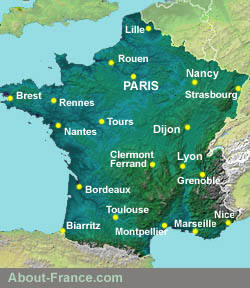How to express the negative in French
Structures of the negative
Like English, French has more than one way of converting an affirmative sentence into a negative sentence.
Let's start with English. The affirmative statement He has some Belgian chocolates, can be put into the negative in different ways, either He doesn't have any Belgian chocolates, or else He has no Belgian chocolates. In the first case the negation is applied to the verb, in the second it is applied to the direct noun object.
Negation can sometimes also be applied to the subject, as in Neither he nor her have any Belgian chocolates .
However the verbal form of negation is much more common in English, and it's just the same in French.
1. Normal negation - applied to the verb
The most common way of putting a statement into the negative, is to add the negative particles ne and pas to the verb.1.1. The standard structure
In a standard French sentence, the negative structure is always the same unless the object is a pronoun
Subject >
NE > Verb1 > PAS
> Verb2 (+ Verb3) (+ direct
object), as in
Il > n' > a > pas > mangé (sa pomme)
Verb 1 is the first verbal element, the one
that is
conjugated: it may be the main verb (in the simple present, future etc,
such as mange, mangerai ) or else it will be an
auxiliary (ai, aura, veux, vais, etc). Verb
2 is a participle or/and an infinitive, depending on the
tense, if one or both of these are neededIl > n' > a > pas > mangé (sa pomme)
Examples:
| Subject | NE | Verb1 | PAS | Verb2 (+3) |
| Je |
NE or n' |
mange |
pas | – |
| ai |
mangé | |||
| veux |
manger | |||
| Il | doit | avoir mangé | ||
| Le garçon | va | manger |
1.2. When the object is a pronoun
The structure is slightly different in statements in which the object is a pronoun.2.1. In standard tenses, where Verb1 is a form of the auxiliary as avoir, or is the main verb itself (with no auxiliary) the structure is.
Subject >
NE > Pronoun obj. > Verb1 > PAS > Verb2 (=past
participle)
Examples: | Subject | NE | Pronoun | Verb1 | PAS | Verb2 |
| Je |
NE |
le | mange |
pas | – |
| l' | ai |
mangé | |||
| Nous | les | avons | mangés | ||
| Les policiers | nous | auront | vus |
Subject >
NE > Verb1 > PAS
> Pronoun obj. > Verb2
(=infinitive)
Examples: | Subject | NE | Verb1 | PAS | Pronoun | Verb2 (+3) |
| Je |
NE / n' |
vais |
pas | le | voir |
| peux |
vous | aider | |||
| Nous | espérons | les | perdre | ||
| Les policiers | oseront | les | arrêter |
1.3. JAMAIS PLUS and GUERE
In addition to pas, French has three other negative particles commonly used with verbs : jamais (never) , plus (no longer, no more) and guère (hardly).They are used just like pas, in appropriate circumstances.
| Je |
NE |
le | mange |
JAMAIS | – |
| Nous | les | avons | mangés | ||
| Je | les | ai | PLUS | vus |
| Je |
NE / n' |
vais |
JAMAIS | le | voir |
| Les policiers | oseront | les | arrêter | ||
| Votre femme | va | PLUS | vous | croire | |
| Ils | peuvent | GUERE | se | comprendre |
1.4. Questions
In negative questions, which are not all that common, the subject of the question in French has to be a pronoun, so the structure is always the same. If a noun subject is required (as in example 3 below), the noun preceeds the pronoun, but (unlike in English) the pronoun cannot be omitted when an interrogative verb structure is used. NE
> Verb1 > Subject pronoun > PAS
(> Verb2)
(+v3) (+object)
Examples:
1. N'avez-vous pas fini de manger?
Haven't you finished eating ?2. Ne voulez-vous pas profiter de
cette
opportunité ?
Don't you want to make the most of this
opportunity ?.3. Le Président,
n'a-t-il pas
fini de parler ?
Hasn't the President finished speaking?4. N'a-t-il pas d'amis parmi les
membres
influents?
Doesn't he have any friends among the influential
members?
2. The alternative - negation applied to a noun
In French, negation can applied to a noun which is the subject or the direct object of a statement. The example given in English at the top of this page could be translated into French as Il a quelques chocolats belges, In French, we can apply the negation to the object, and the result is Il n'a aucun chocolat belge.Important: It is important to remember that in French, unlike English, the key part of the negation, the particle NE, remains attached to the verb. The secondary element, which is pas in verbal structures, is replaced by one of the following:
Adjectives:
aucun / nul /
guère de / plus / ni ... ni
Pronouns : personne / rien
Use of these is most easily shown by a mixed bag of examples, with
negation applied either to the subject or to the objectPronouns : personne / rien
Examples:
Negation on the subject
Negation on the object.
Negation on the subject
1. Personne n'a eu la bonne
réponse.
Noone got the right answer.2. Rien n'est plus facile.
Nothing is easier.3. Aucun candidat n'a
réussi en 2019.
No candidate succeeded in 2019.4. Plus une maison ne restait
intacte
après le séisme
Not a single house was intact after the earthquake.Negation on the object.
5. Je n'ai vu aucun
médecin
ce matin.
I didn't see any doctor(s) this morning.
6a. Il n'y a
guère
d'espoir.
There's not much hope6b. Il n'y a
guère
plus d'espoir.
There's not much hope any longer.7. Ils n'ont rien compris. or
Ils n'ont compris rien.
They didn't understand anything.
8. Il n'y avait nulle raison de le
croire.
There was no reason (at all) to believe him.9. Je ne me fais guère
d'illusions.
I'm not deluding myself.10. Ce gâteau ne
contient ni
beurre ni huile .
This cake contains neither butter nor oil.
Copyright ©
About-France.com
2007 - 2023
| Return to French grammar pages : index | Full site index | Essential French words and phrases for travellers |



